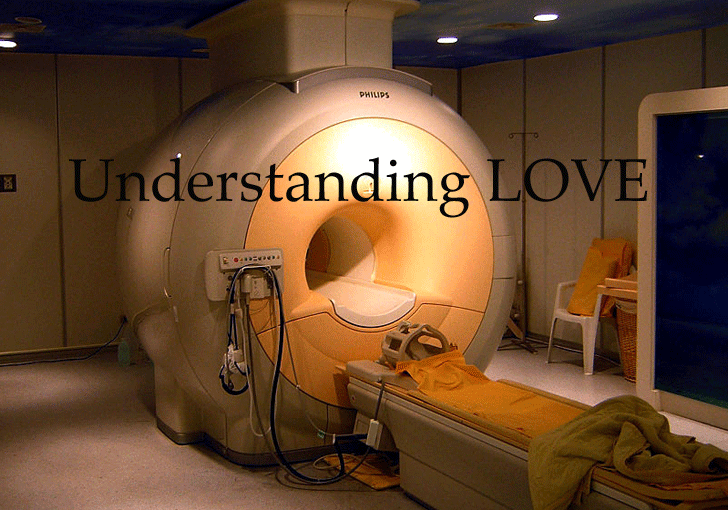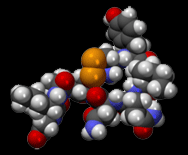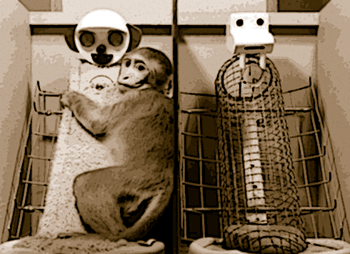

Are you in love right now?At any given time, about half of all adults admit to being "in love". Most of us would say that love is a wonderful feeling -- something we need -- yet an equal number of us have been hurt, or will be hurt, by love.
For such a common and powerful emotion, most people know very little about the origin, nature and function of love. Hopefully, this story about the latest brain research will change that.
Love has been the subject of novels, movies and dreams. Sometimes it is all we can think about. Love has also been the focus of neuroscientists who have been watching love for over a decade using powerful Magnetic Resonance Imagers (MRI) that reveal networks and activity in the brain with colorful 3-D digital computer images.
A functional MRI detects changes in blood flow to different parts of the brain, which reflect the degree of brain activity in those areas.
By comparing the fMRI patterns for the different kinds of love (there are five) it is possible to see similarities and differences in their centers of activity and neural wiring.
I'll attempt to summarize some of these fMRI scans showing the variety of brain centers that are activated with the different kinds of love. You will see evidence that falling in love is no random act, that some relationships are doomed to fail and that an entire brain system exists to keep you happily attached to your mate... if you can manage to turn it on.
The Different Kinds of Love
There are five types of love: Altruistic Love, Maternal Love, Sexual Love, Romantic Love and Attachment Love. Of course, you are understandably more interested in the last three kinds of love, so let's get the first two out of the way.
Altruistic Love
The edict of most religions commands that we "love" our neighbor. Some philosophers have argued (Kant and Kierkegaard come to mind) that this kind of neighborly love excludes not only sexual and romantic love, but friendship as well. They argue that altruistic love should be distributed equally and without preference. Having a "special someone" is not part of the deal and, they argue, it is prohibited.
Other philosophers argue that altruistic love is not really love at all, but a form of respect. You must respect someone before you love them but respect does not always evolve into love.
Not many people can adhere to long periods of altruistic love, unless you are, for example, a Tibetan monk. These monks devote their lives to practicing non-attachment and fostering compassion without preference. They are the epitome of altruistic love.
Neuroscientists have recently measured the brain activity of Tibetan monks in an MRI machine at the UC Davis Center for Mind and Brain during which time they were asked to express (feel) compassion[3].

[Above left:] Magnetic Resonance Image (MRI) of a Monk's brain during meditation when he was asked to actively "extend compassion". Not surprisingly, the medial prefrontal cortex was activated -- an area usually associated with empathy and The Theory of Mind. Activity is most pronounced in the area associated with processing "rewards" [5].
[Above right:] A different view of the same MRI showing activity in the striatum, another area also associated with processing "rewards". We will encounter the striatum again with other kinds of love.
 When neuroscientists say that an area is processing "rewards", they mean that some behavior has triggered the release of euphoric hormones like oxytocin, vasopressin or dopamine. It strongly suggests that the brain has been wired to respond positively to certain thoughts or behavior -- most often, but not always, to our benefit.
When neuroscientists say that an area is processing "rewards", they mean that some behavior has triggered the release of euphoric hormones like oxytocin, vasopressin or dopamine. It strongly suggests that the brain has been wired to respond positively to certain thoughts or behavior -- most often, but not always, to our benefit.
The striatum is an area of the brain especially rich in oxytocin and dopamine innervation. It not only rewards us with euphoria when we successfully achieve our craving (i.e. food, drink, sex) but it rewards behavior that will eventually lead to satisfying our needs. Think about the bell in Pavlov's experiments with feeding dogs. The significance of this will soon become apparent.
Let's take a look at four main ingredients in love.
- Oxytocin has been called the brain's "love hormone" because it is intimately involved in sexual arousal, pair bonding and orgasmic pleasure. When your brain gets a hit of oxytocin it shuts down or inhibits the mental processes that produce anxiety, fear, restricted behavior and negative emotions. All that's left is good, and that's exactly how you feel[4].
Oxytocin is responsible for bonding, monogamy, parenting -- any activity that requires close association with another individual. It can selectively shut off suspicious emotional areas of the brain, promoting friendships and trust.
- Vasopressin is a chemical with many similarities to oxytocin. It regulates the release of water by the kidneys and maintains blood pressure by constricting the blood vessels and making the heart beat faster. In the brain, it is the energy that drives sexual pleasure prior to orgasm. Vasopressin seems to work with oxytocin, often modulating its effects.
- Serotonin is a neurotransmitter that, when low, causes obsessive thoughts and behavior. It lowers when one "falls in love" and contributes to obsessive thoughts of the beloved during Romantic love.
- Dopamine is a neurotransmitter that drives the brain's reward and pleasure centers. In short: dopamine binding with a dopamine receptor produces the feeling and perception of pleasure.
Once an action or behavior has triggered the dopamine rush, the mind begins to seek ways to continue or repeat the behavior. The dopamine system enables us not only to see and recognize goals in our environment, but motivates us to take action to move toward them.
In studies of gamblers, cocaine users and even people playing computer games for small amounts of money, these dopamine sites become extremely active as people score or win, neuroscientists say.
In the case of the Tibetan monks, it appears that compassion and altruistic love have some pleasant emotional benefits from of stimulated oxytocin neurons in the striatum. Buddhism is a very difficult discipline but the brain's altruistic love network provides a means of mediating the sacrifices of non-attachment and austerity with a neurochemical happiness.
Maternal Love
Back in the 1950s Henry Harlow conducted his famous experiments about maternal love on Rhesus monkeys. He demonstrated that the bond between mother and child begins immediately after birth and is vital to the infant's ability to develop social and sexual bonding as an adult.
|
Harlow's Experiment
Both dolls were capable of dispensing milk through a nipple which could be turned on and off. Harlow's first observation was that monkeys who had a choice of both mother dolls spent more time clinging to the terry cloth surrogates, even when their milk came from nipples on the bare wire mothers. When the infants were separated into two groups and assigned either a wire frame or terry cloth mother, they all drank and ate equal amounts of food and grew at the same rate. But there were some striking differences when each group faced stress. When faced with a loud teddy bear beating a drum, monkeys who had soft, terry cloth mothers made bodily contact with their mothers, rubbed against them, and eventually calmed down. Harlow theorized that they used their mothers as a "psychological base of operations", allowing them to remain playful and inquisitive after the initial fright had subsided. In contrast, monkeys raised by wire mesh surrogates did not retreat to their mothers when scared. Instead, they threw themselves on the floor, clutched themselves, rocked back and forth, and screamed in terror. Harlow noted that these activities closely resembled the behaviors of autistic and deprived children frequently observed in institutions as well as the pathological behavior of adults confined to mental hospitals. This confirmed for Harlow the belief that maternal love involves intimate contact between mother and child and that this need is greater than just providing nourishment. But there were some more surprises to come.
[source]
|

[Above:] fMRI Scan for subjects viewing a photograph of their child and experiencing maternal love. The main activated areas are the striatus (caudate and putamen), insula, and ACC. These areas are involved in the reward system and are rich in oxytocin, vasopressin and dopamine circuitry.
The most important ingredient in maternal love appears to be oxytocin's ability to shut off certain areas of the brain that usually contribute negative ideas and uncomfortable feelings and would otherwise be critical of the beloved's behavior. The mother can see no bad in her child and the infant only knows good from its mother (even when she is made from cloth).
An example of an oxytocin inhibited brain region is the putamen (part of the striatum) which is capable of very negative thoughts.
Recent, tentative studies have suggested that the putamen may play a role in the so-called "hate circuit" of the brain. A recent study was done in London by the Department of Cell and Developmental Biology at University College London. An fMRI was done on patients while they viewed a picture of people they hated and people who were "neutral". During the experiment, a "hate score" was recorded for each picture. The activity in sub-cortical areas of the brain implied that the "hate circuit" involves the putamen and the insula. It has been theorized that the "putamen plays a role in the perception of contempt and disgust, and may be part of the motor system that's mobilized to take action." [source]
By varying the amount of oxytocin in experimental animals (rats and voles), neoroscientists have been able to turn on and shut off maternal behavior (aggressively protecting their infant, cuddling and nursing) that is usually associate with maternal love. If similar systems operate in the human brain then perhaps bad maternal skills can be attributed to a mother's own lacking of maternal love -- touch, motion and play -- as an infant.[8][9]
When asked about the significance of mother-infant bonding for the human infant, Harlow estimated that this process, the ability to bond with another, is irreversibly established in the first six months of life. It is thought that oxytocin receptors and neurons develop (or fail to develop) in this period. A lesser number of these receptors (and lower oxytocin) would mean being less able to quiet brain centers that produce fear, anger, hatred and distrust. This would produce anti-social behavior in adults.
The inability to be a "sensitive parent" has been linked with decreased oxytocin receptors. [16] Likewise, mothers with high attachment were found to have more oxytocin than less attached mothers. [22] Mothers who were deprived of maternal love will neglect their own offspring, perpetuating the dysfunction.
We need to remember that Harlow's experimental "mother" was inanimate and incapable of maternal love. But that infant "perceived" the comfort of the terry cloth doll as maternal love. The brain was tricked... by love.
|
New Theory on Why Men Love Breasts
Larry Young, a professor of psychiatry at Emory University who studies the neurological basis of complex social behaviors, thinks human evolution has harnessed an ancient neural circuit that originally evolved to strengthen the mother-infant bond during breast-feeding, and now uses this brain circuitry to strengthen the bond between couples as well. The result? Men, like babies, love breasts. When a woman's nipples are stimulated during breast-feeding, the neurochemical oxytocin, otherwise known as the "love drug," floods her brain, helping to focus her attention and affection on her baby. But research over the past few years has shown that in humans, this circuitry isn't reserved for exclusive use by infants.
|
NEXT --Lust, Romance and Attachment: Shifting Goals


 Rhesus monkeys were immediately separated from their biological mother at birth. They were raised by two man-made dolls, barely resembling a mother monkey. One mother was made out of bare wire mesh while the other was a cardboard and foam rubber mother covered with soft terry cloth.
Rhesus monkeys were immediately separated from their biological mother at birth. They were raised by two man-made dolls, barely resembling a mother monkey. One mother was made out of bare wire mesh while the other was a cardboard and foam rubber mother covered with soft terry cloth. Why do straight men devote so much headspace to those big, bulbous bags of fat drooping from women's chests? Scientists have never satisfactorily explained men's curious breast fixation, but now, a neuroscientist has struck upon an explanation that he says "just makes a lot of sense."
Why do straight men devote so much headspace to those big, bulbous bags of fat drooping from women's chests? Scientists have never satisfactorily explained men's curious breast fixation, but now, a neuroscientist has struck upon an explanation that he says "just makes a lot of sense."